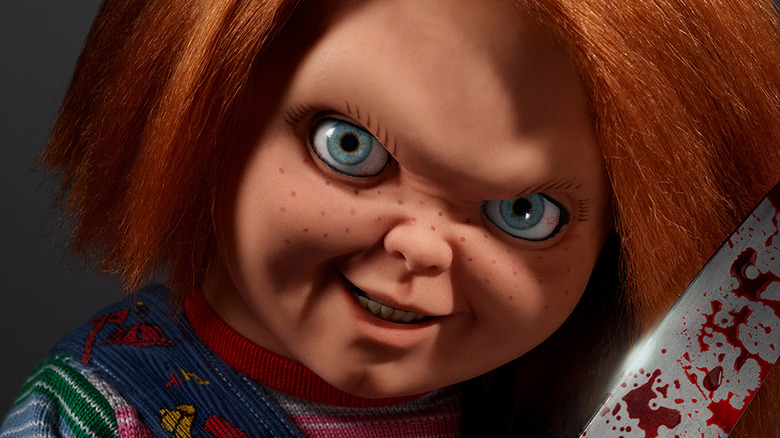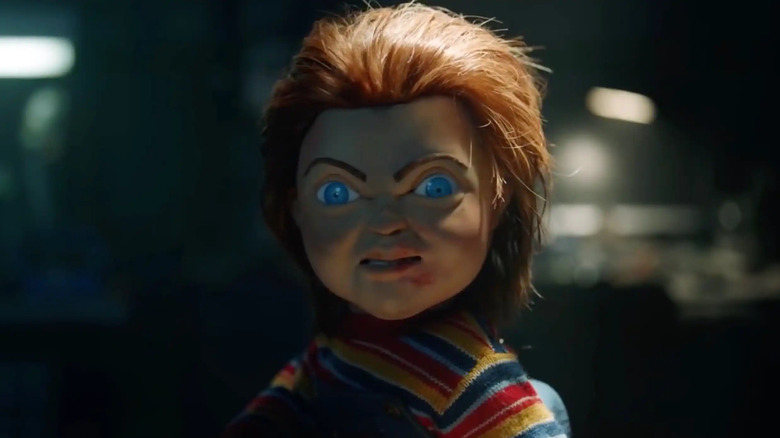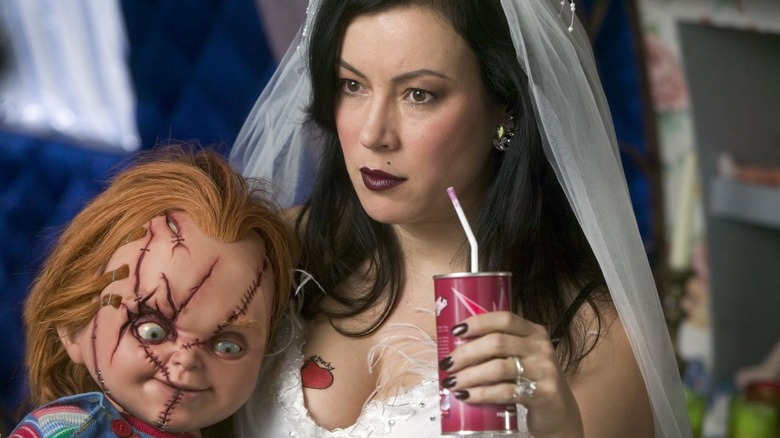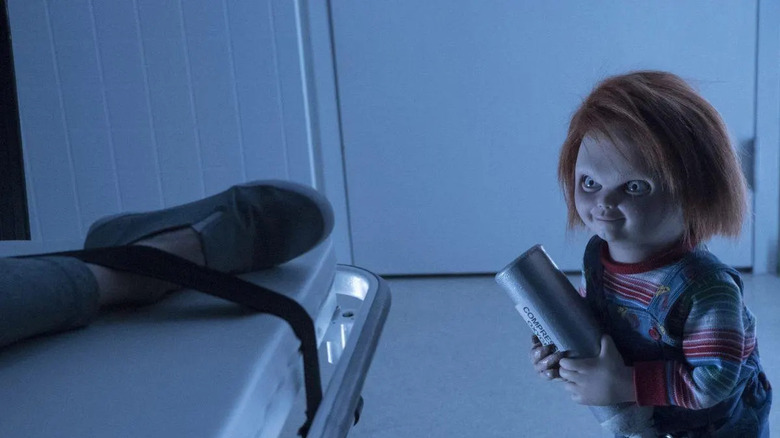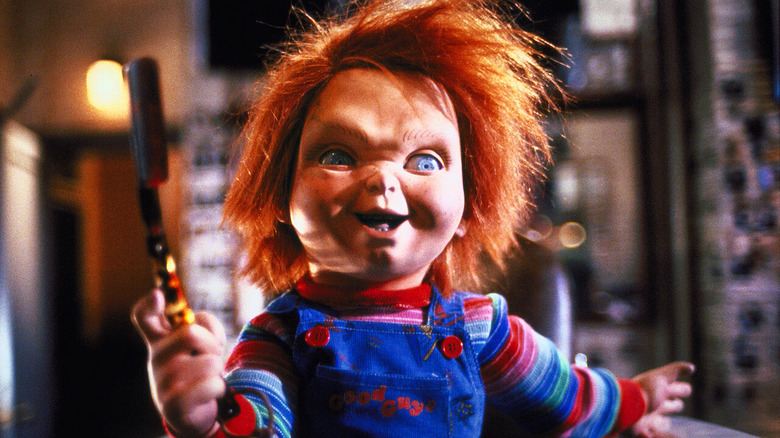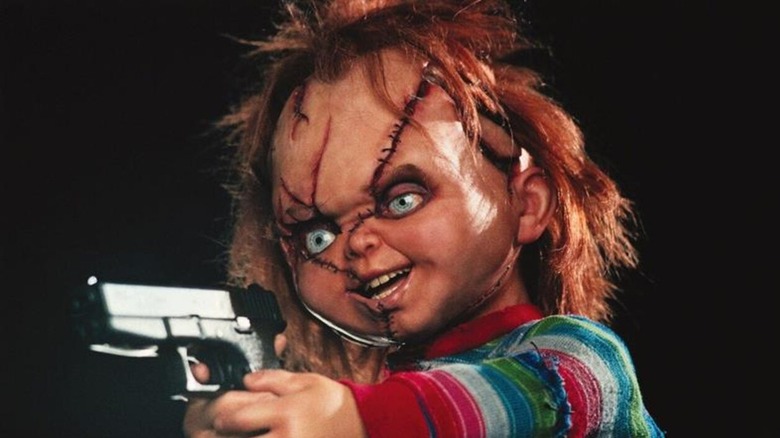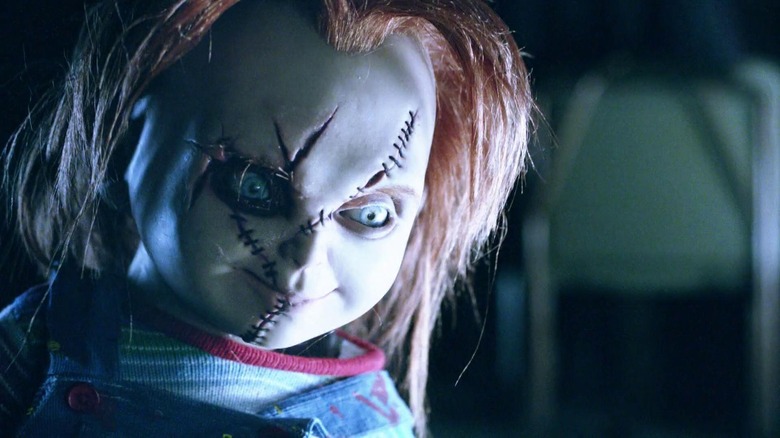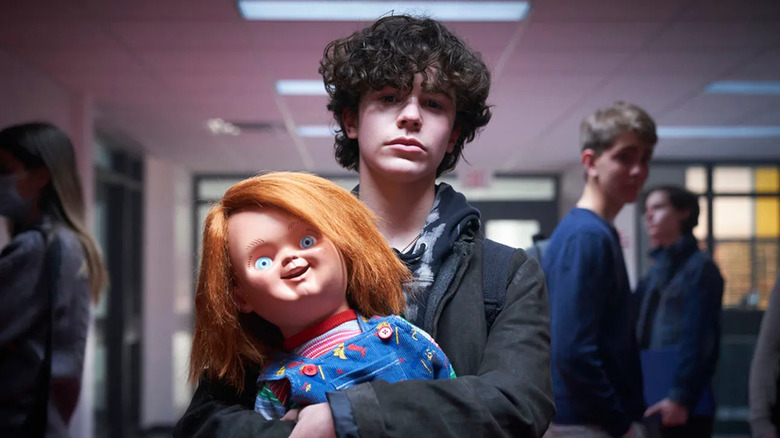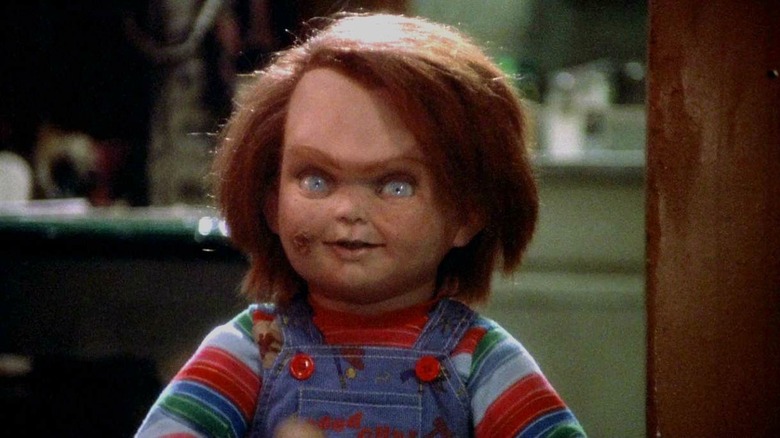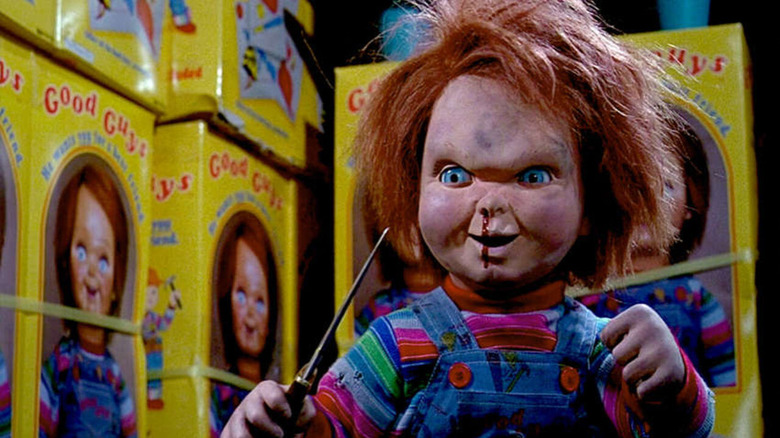Chucky Never Dies: Ranking The Child's Play Franchise From Worst To Best
Against all odds, the "Chucky" franchise endures.
Save for a not-great remake/reboot (which we'll get to momentarily), the original franchise has endured with the same creative force behind the scenes. Writer Don Mancini was the person who came up with Chucky, and he's been writing the series ever since, eventually making the shift to behind the camera to direct the films as well. That has transcended mediums, moving from the big screen to the small with the now ongoing "Chucky" TV series.
The basic set-up, in case you aren't aware: serial killer Charles Lee Ray (Brad Dourif) racked up quite a body count in Chicago as the Lakeshore Strangler. In addition to being a serial killer, Charles Lee Ray also dabbled in voodoo, and he used his voodoo powers to transfer his soul into the plastic body of a "Good Guy" doll (a toy modeled after the popular My Buddy dolls) after being fatally shot.
Ray, now reborn as Chucky, must transfer his soul into a human body or be stuck forever. The rules of voodoo, which are apparently very strict, say that he has to transfer his soul into the first person who learns his true identity. Initially, that would be Andy Barclay, a hapless young boy who receives Chucky as a birthday present. From this scenario sprung a high body count and an entire franchise.
Eventually, the filmmakers stopped worrying about Chucky transferring his soul and instead focused on all the mayhem a little killer doll could cause. Along the way, Chucky picked up an accomplice, his former girlfriend Tiffany (Jennifer Tilly), who quickly found her soul transferred into a doll as well. The series only got weirder and wilder from there.
There's something delightful about the fact that Chucky has soldiered on while other horror franchises have come and gone. What also makes the series so special is its ability to adapt and change — Chucky works in almost any setting and scenario, and over the years the franchise has shifted in tone and focus while always keeping its core elements in place. You have to respect that.
And now, let's rank the "Child's Play" franchise from worst to best.
9. Child's Play (2019)
How Does Chucky Come Back From the Dead at the Beginning: The "Child's Play" remake changes things up. Chucky is not a possessed doll in this film. Instead, he's a malfunctioning robo-toy, sabotaged by an overworked employee in a factory in Vietnam.
Why It's Ranked Here: Remaking "Child's Play" without the involvement of creator Don Mancini and Chucky actor Brad Dourif was always a terrible idea, but they went ahead and did it anyway. The results are rather dire. The 2019 "Child's Play" has none of the charm of the original franchise, and while there are some gruesome kills, they lack the panache that one expects from the series. Mark Hamill's take on Chucky isn't bad — he makes the doll a lot more sympathetic than Dourif's iconic version. And the film deserves credit for going with a mostly practical Chucky instead of making the character CGI. But almost nothing here really works, not even the usually wonderful Aubrey Plaza, who is miscast as a cool mom. And making Chucky a robot reeks of someone having a dumb "how do we make Chucky modern and hip to the kids of today?" note along the way. While by no means a box office flop, the 2019 "Child's Play" was so disliked by critics and fans that any plans for future installments with this new Chucky seem to be dead. No one is complaining.
How Does Chucky Die at the End: Aubrey Plaza cuts his head off. We should all be so lucky.
8. Seed of Chucky
How Does Chucky Come Back From the Dead at the Beginning: Chucky's kid Glenn resurrects Chucky (and Tiffany) from the afterlife and transfers their souls into the dolls being used as props for a Chucky movie.
Why It's Ranked Here: This is the silliest film in the series, and that's saying something, since this is an inherently silly franchise. It's also the first film that goes for full-blown comedy rather than a mix of comedy and horror. Even the more popular "Bride of Chucky," which preceded this film, managed to balance horror and comedy better. "Seed of Chucky" was the first film with Chucky creator Don Mancini in the director's chair, and it's not a very nuanced start. The premise has promise: there's a film being made about Chucky's murders, and Chucky and Tiffany are resurrected on the film set. The murderous couple finds out they have a child, another doll named Glenn (voiced by Billy Boyd). Meanwhile, Jennifer Tilly, playing herself, struggles to land a part as the Virgin Mary in a new biblical epic being directed by rapper Redman (also playing himself).
All of these plotlines converge into a truly stupid movie where almost none of the jokes work and Chucky becomes a shadow of his former self. Still, there are a few things to enjoy about "Seed of Chucky." First and foremost is a cameo from trash cinema master John Waters, playing a tabloid journalist. And also ... well, that's it. The "Child's Play" franchise was never high art, but "Seed of Chucky" took the series to an all-time low. Thankfully, it eventually recovered.
How Does Chucky Die at the End: Glenn dismembers him with an axe.
7. Cult of Chucky
How Does Chucky Come Back From the Dead at the Beginning: Chucky's just sort of already alive at the start of this, in various different forms.
Why It's Ranked Here: "Cult of Chucky" isn't great. Yet you cannot deny this sequel deserves credit for being committed to being insane. We're talking even more insane than "Seed of Chucky." Writer-director Mancini sets the film within the confines of a mental institution, which seems like the perfect opportunity to take the series to a new location. But the institution is almost an afterthought here — the film could take place almost anywhere and unfold pretty much the same way.
Much of the pre-marketing push for the film focused on the return of Alex Vincent, the actor who played Andy, Chucky's first "friend", in "Child's Play" 1 and 2. While Vincent does appear here, his character is underused and seems to only be present to set up another sequel. That's fine, but it would've been nice if he had been given more to do here as well. The one (or technically speaking, more than one) thing "Cult of Chucky" has going for it is the fact that there are multiple Chuckys here. Chucky has been brushing up on his voodoo and is now able to transfer his spirit into multiple dolls at once. It's a neat idea, and it's a hoot to listen to Brad Dourif converse with himself. But you can't help but wish the film had done more with the concept. From a visual standpoint, "Cult of Chucky" is often surprisingly gorgeous, with a stark minimalism at play within the walls of the asylum mixed with a snowy winter backdrop. Yet just as often, there's a cheapness to everything, particularly in scenes featuring Chucky props that look more unconvincing than they ever have before.
How Does Chucky Die at the End: Andy beats the crap out of one of the Chucky's, then shoots him a bunch of times. But the main Chucky lives on.
6. Child's Play 3
How Does Chucky Come Back From the Dead at the Beginning: Play Pals, the company that makes Good Guy dolls, recycles some destroyed bits of Chucky from the previous film to create a new doll.
Why It's Ranked Here: "Child's Play 3" was the first real indication that the franchise might be spinning its wheels. The film actually came out less than a year after "Child's Play 2," hinting at a rushed production trying to cash in on Chucky's growing popularity. In the film, a teenage Andy (played by Justin Whalin) is shipped off to military school. That's bad enough on its own, but things go from bad to worse when Chucky finds his way onto campus.
The idea of Chucky bucking up against rigid military tradition is great, and relocating the franchise to a military base gives the story an excuse to let Chucky get his hands on some new weapons. But "Child's Play 3" lacks the charm of much of the franchise. It feels colder, more removed. It also comes across as a one-note movie — Chucky vs. the army, over and over again. Once you get passed the novelty of that initial idea, it becomes clear the film doesn't have a whole lot more to offer. Yet as always, there are things to enjoy here, particularly the finale, which shifts away from the military base to a carnival, where Chucky terrorizes the film's characters on one of the most elaborate, and dangerous, haunted house rides ever created. You can really sense, however, that Mancini is starting to realize he needs to stop repeating the same Chucky formula — that is, stop having Chucky constantly chasing after Andy — and do something new. And new is exactly what we got for the next entry in the series, which just happens to be the next entry on this ranking.
How Does Chucky Die at the End: Chucky falls into a giant fan and is obliterated. He'll be back though, of course.
5. Bride of Chucky
How Does Chucky Come Back From the Dead at the Beginning: Tiffany steals the obliterated Chucky pieces from "Child's Play 3," stitches them back together, and uses a "Voodoo for Dummies" book to bring Chucky back to life.
Why It's Ranked Here: The stagnant feeling of "Child's Play 3" was successfully overcome by 1998's "Bride of Chucky." Hong Kong filmmaker Ronny Yu helmed Mancini's script, and gave Chucky a whole new feel — slick, polished, more modern. Or, as modern as something in 1998 can be. Mancini finally stopped worrying about Chucky trying to put his soul into Andy Barclay and crafted a "Natural Born Killers" meets "Bonnie and Clyde"-style road movie. Chucky is brought back by his old flame Tiffany (Jennifer Tilly, who gives the series as a whole a much-needed boost). Tiffany soon finds herself reincarnated as a doll as well, and the couple hitch a ride with a pair of hapless teens, racking up a body count along the way.
While almost all the previous "Child's Play" films (save the first) were open to using humor, "Bride of Chucky" is the first film in the franchise that seems like it's in on the joke. By now, Chucky had changed into something of a comical anti-hero, and Mancini's script leans into that here while also still maintaining that Chucky is bad news. "Scream" had just reinvented the horror genre, making it seem like what audiences wanted were not straight-up horror films, but horror that winked at its audience; horror that wasn't afraid to be self-referential. Not all the jokes work here, but there's a tongue-in-cheek nature to "Bride of Chucky" that succeeds far better than the non-stop jokes of "Seed of Chucky." There's also a doll-on-doll sex scene, which Yu shoots in a hilariously tender, even romantic way — lit by flickering fire from a fireplace — that makes the scene work much better than it should.
The key ingredient to "Bride"'s success is Tilly, who has the perfect voice for this type of role. Chucky, having been a loner for so long, has never had someone to bounce his lines off of before. Giving him the opportunity here is a gold mine, and Tilly and Dourif have great (vocal) chemistry and handle the banter well.
How Does Chucky Die at the End: He gets shot. Kind of anticlimactic, as far as Chucky deaths go.
4. Curse of Chucky
How Does Chucky Come Back From the Dead at the Beginning: He's already alive at the start. No explanation is given.
Why It's Ranked Here: After the near-fatal misstep that was "Seed of Chucky," the franchise needed a bit of an overhaul. "After 'Bride' and 'Seed,' which of course were comedies, we wanted to take a severe turn back into ... horror territory," Mancini said. "It's what the fans have been saying they wanted, and after the last two I think we mined the comedic stuff as much as we could, for now. I think Chucky is a particularly versatile character and I think he can be plugged into a number of different forms. But it was time to go back to his roots."
"Curse of Chucky" is almost a remake, but not quite. Mancini changes up the setting, with this film taking place in an old, dark house. "Curse of Chucky" becomes something like a murder mystery in the process; the type of tale Agatha Christie might have written if she had an interest in vulgar murder dolls. Fiona Dourif, daughter of Chucky actor Brad Dourif, plays Nica, a young woman in a wheelchair. After her overbearing mother dies, Nica's nosy sister and her family take up residence in the house, with the hope of forcing Nica out so they can sell the property. Meanwhile, someone has mysteriously shipped a Good Guy doll to the house, and wouldn't you know it, it's Chucky. And he has some unfinished business with Nica's family, which we learn about through flashbacks that allow Brad Dourif to play Charles Lee Ray again.
Where "Seed of Chucky" was over-the-top to the extreme, "Curse" is subtle. Or at least as subtle as a "Chucky" movie can get. The kills aren't played for laughs here, which effectively makes Chucky (kind of) scary again. Also helping matters is Fiona Dourif, who gives us our first real main character to root for in the series since Andy Barclay vacated. The simple fact is, after "Seed of Chucky," almost anything was going to look better in comparison, but thankfully Mancini and company put some real thought and effort into "Curse," resulting in one of the best entries in the franchise.
How Does Chucky Die at the End: He doesn't! Not in the main narrative, at least. In a post-credit scene, however, Andy Barclay returns and (apparently) shoots Chucky in the face with a shotgun. But as "Cult of Chucky" reveals, that doesn't actually kill him either. Chucky never dies!
3. Chucky
How Does Chucky Come Back From the Dead at the Beginning: The "Chucky" series picks up after the events of "Cult of Chucky," where the Charles Lee Ray-possessed doll is purchased by queer teen artist, Jake Wheeler (Zackary Arthur) at a yard sale in Hackensack, New Jersey. Jake intends to sell the doll, but of course, that doesn't work, and now Chucky is hell-bent on using Jake as his new scapegoat to enact a reign of terror on Charle Lee Ray's hometown.
Why It's Ranked Here: The "Chucky" series is nothing short of brilliant, as creator Don Mancini has effortlessly managed to weave the three eras of "Child's Play" films into one, coherent, intertwining story. The traditional slasher scares of the first era ("Child's Play 1, 2, 3") are present, the queer, camp excellence of the middle era ("Bride" and "Seed") are central to the story's plot, and the expansive dangers of the latter era films ("Curse" and "Cult") make Chucky's existence a much bigger threat than just the singular doll.
The series is the culmination of everything that makes the "Chucky" franchise great, balancing genuinely terrifying kills with sharp-tongued comedy and a hell of a lot of heart. It's also a testament to the brilliant storytelling of Mancini because the series never misses a canonical beat. At the same time, it's not afraid to lean into the absurdity. Jennifer Tilly is a walking Grande Dame Guignol and Devon Sawa is now on his fourth different character. It's also unapologetically gay as hell, a sign that society is finally getting to a place where Mancini can tell the story he's always wanted to tell, without compromise.
How Does Chucky Die at the End: Our favorite pint-sized slasher is still kickin' it well into season 3, and has even made his way to the White House. You just can't keep a Good Guy down.
2. Child's Play
How Does Chucky Come Back From the Dead at the Beginning: He transports his own soul into the body of a Good Guy doll.
Why It's Ranked Here: If you've made it this far, you might be shocked to see that "Child's Play," the first film, the film that launched the franchise, isn't number one on the list. There's a reason for that: while "Child's Play" gave birth to Chucky, it had yet to fully understand his full potential. For a good portion of this 1988 film, director Tom Holland (no, not Spider-Man; a different Tom Holland) tries to tease the audience about whether or not Chucky is even alive, or rather the insane imaginings of young Andy Barclay. There's nothing wrong with this concept, but the film completely abandons it at the midway point, which inadvertently makes the first half of the movie weaker by comparison. "Child's Play" plays things straight; very straight. There's not a single moment in this film that treats the concept of a living, killing child's toy as anything other than serious. While that's commendable, it also doesn't quite work, just because the concept itself is too inherently amusing to begin with. That's not to say "Child's Play" should've been a laugh riot, or worse, been completely over the top like "Seed of Chucky." But there are moments where you can't help but think the film is taking itself too seriously.
Still, this is a hell of a lot of fun to watch. Dourif's performance in this film is nasty to the extreme; this was before multiple sequels softened Chucky a bit and turned him into an anti-hero. Here, he's nothing but trouble, killing almost anyone he comes across, often for no discernible reason. He just likes to kill, and being stuck in a tiny doll body isn't going to stop that. A scene where Karen Barclay (Catherine Hicks), Andy's mother, slowly realizes that Chucky — her son's doll that has been talking and moving its head for days — has no batteries inside him is a perfect moment of ever-mounting tension, punctuated by Chucky springing to life with a barrage of vulgarity. Moments like this help elevate "Child's Play" to almost the top of the list. Almost.
How Does Chucky Die at the End: Chucky is set on fire, burnt to a crisp, has multiple appendages (and his head) blown off by gunfire, and then is finally shot in the heart. Wonder if he'll be back?
1. Child's Play 2
How Does Chucky Come Back From the Dead at the Beginning: Desperate to calm stockholders, Play Pals takes the burnt remains of Chucky from the first film and rebuilds them, with the hopes of proving Andy's story was bunk and there's nothing wrong with the doll. Of course, they're wrong.
Why It's Ranked Here: Here it is — the best "Child's Play" film. While "Child's Play" set up the world and rules of Chucky, "Child's Play 2" fully realized how to make the most of them. This is a funny, weird, twisted film, filled with iconic moments that the franchise has never quite been able to top. Most of all, this film is fun while also being scary. While the subsequent sequels could never entirely balance the humor and horror, "Child's Play 2" does it marvelously, with funny moments punctuated by truly disturbing death scenes.
After "Child's Play," Andy is sent to a foster home. There, he struggles to readjust to normal life, all while everyone around him is suspicious of the events of the first film. One thing's for sure: there's no way anyone believes his story about a killer doll. Of course, Andy is telling the truth, and a resurrected Chucky soon finds his way back into Andy's life. This is the best-directed film in the series, with helmer John Lafia employing fish-eye lenses and strange angles to always give the film a sense of uneasiness and menace. Dourif really finds his groove with the part of Chucky here, and he's clearly having a blast as the character. This is the first film in the series that lets Chucky employ his now-trademark laugh; a high-pitched cackle full of gleeful evil. It's a hoot.
Best of all, though, is the film's climax, which is set within the maze-like confines of the Play Pals factory, where more and more Good Guy dolls are being constructed. With shades of "The Terminator," Chucky chases Andy and his cool-as-hell foster sister Kyle (Christine Elise) through the factory while towers and towers of stacked Good Guy doll boxes gaze down at them. Rube Goldberg-like machines eventually transform Chucky into a mutated monster, but he just keeps coming. He'll always keep coming, his thirst for blood unquenched. For close to 30 years now, Chucky has worked his way through horror's hallowed halls and come out the other end basically intact. No matter how often he's shot, stabbed, burnt, or blown up, he always returns.
How Does Chucky Die at the End: After being covered in molten plastic, Chucky gets an air hose stuck in his mouth and proceeds to explode.
